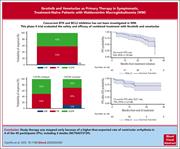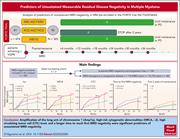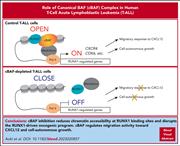Issue Archive
Table of Contents
BLOOD COMMENTARIES
REVIEW ARTICLE
The lifelong natural history of clonal hematopoiesis and its links to myeloid neoplasia
Fabre and Vassiliou review the current understanding of the natural history of clonal hematopoiesis (CH) and its relationship to myeloid malignancy. Increasing CH with age reflects age-related attrition of hematopoietic stem cells that favors emergence of clonal dominance. The authors discuss what is known of the cell-intrinsic and cell-extrinsic forces underlying clonal behavior and their implications for better predicting malignant progression and intervening to slow or prevent the emergence of malignancy.
CLINICAL TRIALS AND OBSERVATIONS
Ibrutinib and venetoclax as primary therapy in symptomatic, treatment-naïve Waldenström macroglobulinemia
Clinical Trials & Observations
Castillo et al report on an investigator-initiated trial of ibrutinib and venetoclax in MYD88-mutated Waldenström macroglobulinemia. The primary end point of very good partial response was achieved in 42% of patients, with progression-free and overall survival of 76% and 96%, respectively. Unfortunately, the trial was stopped prematurely because of a surprisingly high rate of ventricular arrhythmia occurring in 4 patients, including 2 deaths.
Predictors of unsustained measurable residual disease negativity in patients with multiple myeloma
Clinical Trials & Observations
Brief Report
Two articles examine relapse of patients with multiple myeloma despite achieving measurable residual disease negativity (MRDneg). D’Agostino and colleagues monitored 306 patients for a median follow-up of 50.4 months from achieving MRDneg, with loss of negativity occurring in 39% of patients. In the second study, Guerrero and colleagues addressed the same question for 267 newly diagnosed patients who were MRD negative following primary treatment and autograft with remarkably similar results, with 42% having recurrent MRD or relapse with a median follow-up of 73 months. In both studies, prolonged time to reach MRDneg, circulating tumor cells at diagnosis, and high-risk cytogenetics all predict for relapse.
Don’t let the genie out of the bottle!
Clinical Trials & Observations
Predictors of unsustained measurable residual disease negativity in transplant-eligible patients with multiple myeloma
Clinical Trials & Observations
Brief Report
Two articles examine relapse of patients with multiple myeloma despite achieving measurable residual disease negativity (MRDneg). D’Agostino and colleagues monitored 306 patients for a median follow-up of 50.4 months from achieving MRDneg, with loss of negativity occurring in 39% of patients. In the second study, Guerrero and colleagues addressed the same question for 267 newly diagnosed patients who were MRD negative following primary treatment and autograft with remarkably similar results, with 42% having recurrent MRD or relapse with a median follow-up of 73 months. In both studies, prolonged time to reach MRDneg, circulating tumor cells at diagnosis, and high-risk cytogenetics all predict for relapse.
Don’t let the genie out of the bottle!
Clinical Trials & Observations
LYMPHOID NEOPLASIA
Canonical BAF complex regulates the oncogenic program in human T-cell acute lymphoblastic leukemia
Aoki et al investigated the signaling pathway that allows T-cell acute lymphoblastic leukemia (T-ALL) cells to migrate toward the niche factor CXCL12. The authors report that canonical BRG1/BRM-associated factor (cBAF) is a required regulator of T-ALL cell migration. cBAF depletion inhibits RUNX1 from binding to target genes, thus impairing proliferation and inducing apoptosis in vitro and in T-ALL xenografts. This suggests that cBAF may provide a new clinical target for the treatment of T-ALL.
MYELOID NEOPLASIA
Acute myeloid leukemias with UBTF tandem duplications are sensitive to menin inhibitors
Upstream binding transcription factor tandem duplications (UBTF-TDs) are a recurrent finding in acute myeloid leukemia (AML) that confer a poor response to chemotherapy. Barajas and colleagues examined transcriptional targets of UBTF-TD in transformed CD34+ cells and patient-derived xenografts. Wild-type UBTF binds to ribosomal DNA loci, and UBTF-TD maintains that binding. However, UBTF-TD also binds to gene loci dysregulated in UBTF-TD AML, including HOXA/HOXB and MEIS1. Like other HOXA overexpressing AML cells, they are sensitive to menin inhibitors, offering a potential therapy for this high-risk AML.
THROMBOSIS AND HEMOSTASIS
Long-term outcomes of pulmonary embolism in children and adolescents
CME
Clinical Trials & Observations
In this month’s CME article, Bastas et al examined long-term outcomes following pulmonary embolism (PE) in 150 children and adolescents in a single-center longitudinal cohort using clinical evaluation, imaging, echocardiography, pulmonary function tests, and exercise testing starting 3-6 months after PE. Outcomes were excellent in patients without underlying conditions, with post-PE syndrome between 0.7-8.5%. Patients with underlying conditions had higher recurrence and more impairment. Exercise intolerance usually reflects deconditioning rather than cardiopulmonary disease, suggesting that return to exercise should be encouraged.
A mechanism for hereditary angioedema caused by a methionine-379–to–lysine substitution in kininogens
Hereditary angioedema (HAE) is a syndrome associated with bradykinin-induced swelling of skin and mucous membranes and is usually attributable to decreased plasma C1-inhibitor activity, leading to increased plasma kallikrein (PKa) and increased release of bradykinin from high molecular weight kininogen (HK). Dickeson et al analyzed a recently described variant of HAE related to a single nucleotide change in the Kng1 gene, which encodes HK and low molecular weight kininogen. The authors demonstrate that the mutation does not change cleavage by PKa but also renders HK susceptible to increased cleavage by plasmin, producing increased bradykinin levels and HAE.
BLOOD WORK
CONTINUING MEDICAL EDUCATION (CME) QUESTIONS
-
Cover Image
Cover Image
![issue cover]()
Human cord blood CD34+ cells expressing FKBP12F36V upstream binding transcription factor tandem duplications (
UBTF -TDs) undergo myeloid differentiation when treated with dTAG-13, resulting in rapid degradation of theUBTF -TD protein. See the article by Barajas et al on page 619. - PDF Icon Front MatterFront Matter
- PDF Icon Table of ContentsTable of Contents
- PDF Icon Back MatterBack Matter
- PDF Icon Editorial BoardEditorial Board
Advertisement intended for health care professionals
Email alerts
Advertisement intended for health care professionals











Risk/benefit of BTK/venetoclax combos: the context matters!
Clinical Trials & Observations